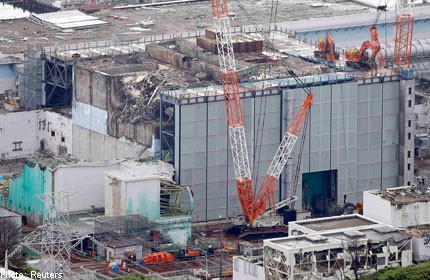No radiation spike at Fukushima despite steam: TEPCO

TOKYO - The operator of Japan's Fukushima nuclear plant insisted Thursday there was no sign of spiking radiation at the crippled facility, after steam was found in a reactor building.
Tokyo Electric Power Co (TEPCO) said it believed rainwater sitting on the reactor was the source of the vapour, which did not contain an abnormally high level of radiation.
TEPCO also insisted that monitoring equipment indicated no change to the status of the plant or to the amount of toxic materials it is releasing.
But the case served as a reminder about the continuing precariousness at the facility more than two years after it was wrecked by a tsunami that sent the plant into meltdown.
Direct access to the reactor is incredibly difficult because radiation levels make it unsafe for people to go near.
However, a worker watching a camera feed of the site spotted the steam in the building housing Reactor 3.
The roof of the building was blown off in a hydrogen explosion in the days after the March 2011 meltdowns, which were sparked when cooling systems were flooded with seawater after a huge undersea quake and tsunami.
Steam was also sighted at least once in July last year, TEPCO spokesman Masayuki Ono told reporters, but added the information was not made public and the vapour disappeared in a short time.
TEPCO has faced repeated criticism for playing down problems or not being open about the difficulties it is facing at Fukushima.
Relatively cool, rainy weather might have prompted the steam seen Thursday, Ono said.
"We believe it is highly likely that rainwater caused the steam," he said.
Neither the temperature of the reactor nor readings at radiation monitoring posts had risen in the hours after the steam was first seen, and the reactor remained subcritical. Criticality is the term used for reactors in which there is a self-sustaining nuclear chain reaction.
The steam was seen near a pool on the fifth floor, which stores devices and equipment removed from the reactor before the disaster as part of regular operations. The pool sits next to the 3 centimetre-thick (1.2 inch) steel structure enclosing the reactor.
The temperature of the container was about 38 degrees Celsius (100 Fahrenheit) early Thursday, according to the company.
Workers were continuing to pump water into the reactor and fuel storage pool as part of continuing cooling efforts, TEPCO said, adding samples taken from the steam showed radiation levels similar to other days.
Tens of thousands of people were forced from their homes by the threat of radiation in the immediate aftermath of the disaster.
While some areas are gradually being repopulated, others may remain off-limits for a generation, as TEPCO struggles to manage a clean-up scientists say could take up to four decades to complete.
The steam is the latest in a growing catalogue of mishaps that have cast doubt on the utility's ability to fix the world's worst atomic disaster since Chernobyl in 1986.
A series of leaks of water contaminated with radiation have shaken confidence, as did a blackout caused by a gnawing rat that left cooling pools without power for more than a day.
The company has admitted in recent weeks that water and soil samples taken at the plant are showing high readings for potentially dangerous and cancer-causing isotopes, including caesium-137, tritium and strontium-90.
Japan's nuclear watchdog said last week the plant was very likely leaking highly radioactive substances into the Pacific Ocean.
Members of the Nuclear Regulation Authority voiced frustration at TEPCO, which has failed to identify the source and the cause of rising readings in groundwater.
The authority's officials are urging TEPCO to offer more detailed and credible data and to try to better explain to the public what it knows.
Most of Japan's nuclear reactors remain off-line, largely due to public distrust of the industry.
Prime Minister Shinzo Abe's Liberal Democratic Party is hoping to restart them.